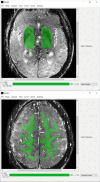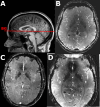Blood Flow Velocity Analysis in Cerebral Perforating Arteries on 7T 2D Phase Contrast MRI with an Open-Source Software Tool (SELMA)
- PMID: 39841291
- PMCID: PMC11754306
- DOI: 10.1007/s12021-024-09703-4
Blood Flow Velocity Analysis in Cerebral Perforating Arteries on 7T 2D Phase Contrast MRI with an Open-Source Software Tool (SELMA)
Abstract
Blood flow velocity in the cerebral perforating arteries can be quantified in a two-dimensional plane with phase contrast magnetic imaging (2D PC-MRI). The velocity pulsatility index (PI) can inform on the stiffness of these perforating arteries, which is related to several cerebrovascular diseases. Currently, there is no open-source analysis tool for 2D PC-MRI data from these small vessels, impeding the usage of these measurements. In this study we present the Small vessEL MArker (SELMA) analysis software as a novel, user-friendly, open-source tool for velocity analysis in cerebral perforating arteries. The implementation of the analysis algorithm in SELMA was validated against previously published data with a Bland-Altman analysis. The inter-rater reliability of SELMA was assessed on PC-MRI data of sixty participants from three MRI vendors between eight different sites. The mean velocity (vmean) and velocity PI of SELMA was very similar to the original results (vmean: mean difference ± standard deviation: 0.1 ± 0.8 cm/s; velocity PI: mean difference ± standard deviation: 0.01 ± 0.1) despite the slightly higher number of detected vessels in SELMA (Ndetected: mean difference ± standard deviation: 4 ± 9 vessels), which can be explained by the vessel selection paradigm of SELMA. The Dice Similarity Coefficient of drawn regions of interest between two operators using SELMA was 0.91 (range 0.69-0.95) and the overall intra-class coefficient for Ndetected, vmean, and velocity PI were 0.92, 0.84, and 0.85, respectively. The differences in the outcome measures was higher between sites than vendors, indicating the challenges in harmonizing the 2D PC-MRI sequence even across sites with the same vendor. We show that SELMA is a consistent and user-friendly analysis tool for small cerebral vessels.
Keywords: 2D PC-MRI; Analysis tool; Blood flow velocity; Perforating arteries; Pulsatility index.
© 2025. The Author(s).
Conflict of interest statement
Declarations. Competing Interests: The authors declare no competing interests.
Figures



References
-
- Björnfot, C., Eklund, A., Larsson, J., Hansson, W., Birnefeld, J., Garpebring, A., et al. (2024). Cerebral arterial stiffness is linked to white matter hyperintensities and perivascular spaces in older adults – a 4d flow mri study. Journal of Cerebral Blood Flow & Metabolism.,44, 1343–1351. - PMC - PubMed
MeSH terms
Grants and funding
LinkOut - more resources
Full Text Sources
Medical
Research Materials
Miscellaneous

